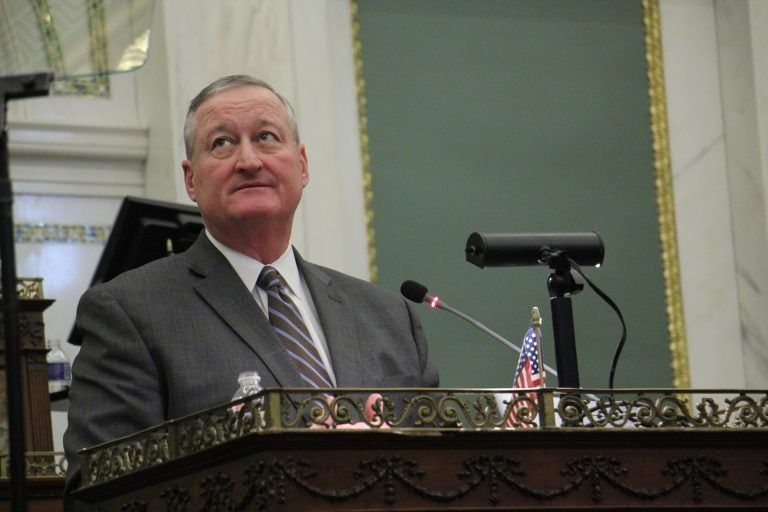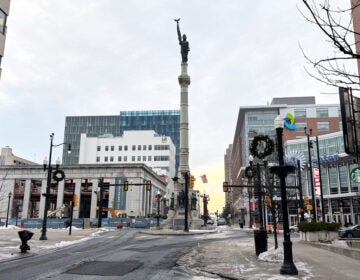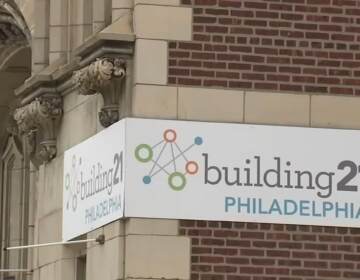Kenney pitches tax hike for schools, businesses, urban blight, vulnerable residents
The big news coming out of Mayor Jim Kenney's annual budget address held Thursday morning in City Council chambers is a proposed six percent increase in property taxes.
Listen 2:22
Philadelphia Mayor Jim Kenney addresses city council as he gives his budget address, March 1, 2018. (Emma Lee/WHYY)
The big news coming out of Mayor Jim Kenney’s annual budget address held Thursday morning in City Council chambers is a proposed six percent increase in property taxes and a delay to planned cuts to the city’s unpopular wage tax in exchange for an unprecedented $980 million investment into city schools. But as Kenney spoke to lawmakers, he introduced a number of other proposals aimed at making good on campaign promises that none of the city’s neighborhoods — nor the people who live in them — will be left behind as new development and an influx of new residents transform the city’s urban core.
“I vow to work with City Council to protect low-income homeowners,” Kenney said. “We will expand housing counseling and outreach with $2.5 million in foreclosure prevention programs. We will boost funding to the Philadelphia Land Bank by nearly $4 million. And we’ll expand the Homestead Exemption in light of growing home values.”
The expansion of the Homestead Exemption intends to cushion low-income homeowners from the proposed property tax increase. It would reduce the taxable portion of residential property assessments from $30,000 to $40,000 and potentially prevent many poorer homeowners from higher tax bills.
While emphasizing the city’s commitment to protecting its “most vulnerable residents,” the mayor highlighted a renewed commitment to “middle neighborhoods” such as Overbrook, West Oak Lane and Oxford Circle where a large portion of the city’s working and middle-class residents live amid rising challenges such as high rates of foreclosure and ailing business districts.
“That is why we are allocating $500,000 in additional funding for investments in our commercial corridors,” he said.
The budget proposal also includes a one-time funding boost to the Philadelphia Land Bank, a nod toward meeting the mayor’s goal of returning abandoned land to productive use. Council President Darrell Clarke recently introduced legislation that sought to increase the nascent institution’s ability to acquire land, and the administration projects that the cash infusion included in the budget would allow for acquisition of an additional 320 tax delinquent properties in fiscal year 2019.
“The Land Bank requested about $3.8 million, and we are giving them $3.8 million,” Anna Adams, Budget Director for the Office of the Director of Finance told PlanPhilly. “That will help them deal with additional acquisitions they plan to make and also support their programming like maintenance of the lots and properties they buy.”
Adams said that the budget proposal does not change much as far as housing and city planning policy goes.
“We have small investments in [the Department of] Planning and Development,” says Adams. “It is paying for positions here and there, which helps that office, but does not have a significant impact on policy.”
Yet Kenney has proposed modest spending increases in many other areas that affect the fabric of neighborhood life. The budget includes pay boosts for seasonal Parks and Recreation workers, a small piece of Kenney’s larger plan to improve the city’s parks and rec centers through his soda tax-funded Rebuild program. On that front, Kenney offered a bit of optimism on the stalemate the city has found itself in as a beverage industry lawsuit challenging the tax winds through the courts.
“I am hopeful that the coming year will bring a final resolution to the lawsuit allowing us to move forward with the full expansion of PHLpreK and Community Schools, and with the capital borrowing for the Rebuild program,’ the mayor said.
Kenney also introduced a five-year commitment of $60 million to Vision Zero traffic safety initiatives, including traffic-calming measures and bike lane improvements.
“We intend to advance ‘Vision Zero’ – the bold public safety plan to eliminate traffic-related deaths by 2030,” said Kenney. “We plan to spend $60 million over five years for re-engineering of dangerous locations, for expanded traffic calming devices, and for more bike lanes.”
Another proposed budget bump with big implications for neighborhoods is an increase of $2 million annually over the next five years for the Department of Licenses and Inspections (L&I). The money would go toward speeding up blight demolition, especially in the case of dangerously unstable buildings. City officials say the money would cover the demo of an estimated 650 residential properties a year, although that number would be reduced if any large commercial buildings are on the termination list. (By comparison L&I is projected to demolish about 500 properties in fiscal year 2018.) They will begin by steering the wrecking balls toward the 167 buildings on the imminently dangerous list.
The administration has also asked the municipal bureaucracy to find ways to do more with less, and 14 departments would see cuts under the proposal. These include snips to the Commerce Department, the Law Department, the Revenue Department, the Streets Department and the prison system, which would see a $2.6 million reduction.
City representatives played down the effects these drawdowns would have, saying that departments were asked to find efficiencies that would limit harms to city services.
“We looked at ways cuts could be [minimized],” said Adams. “One-time investments they could do without, contracts where they thought they could do it in-house, things where we thought we could take down spending levels without it having a dramatic impact on services.”
L&I, for example, found positions it felt the agency could do without and did not replace some workers in those jobs who retired. The Department of Planning and Development found other funds to support existing programs, dipping into the Housing Trust Fund and other forms of grant funding to make up for city cutbacks.
The administration acknowledges that their all-out effort to keep the School District funded means that the rest of the budget is tight, with little room for ambitious new spending programs in other areas. With that in mind, he urged lawmakers and residents to remember that the benefits to properly funded schools will extend beyond the children in the classroom and help the city as a whole. If taxpayers remain patient.
“All of these efforts will take years to fully realize their worth, Kenney said. “But we expect to see steady and incremental progress each year … with more students reading on grade level, graduating, and successfully transitioning into college and careers. And neighborhoods will flourish around a growing number of successful schools.”
WHYY is your source for fact-based, in-depth journalism and information. As a nonprofit organization, we rely on financial support from readers like you. Please give today.







